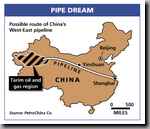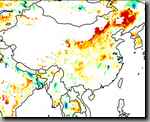
The CO2 Matrix: Yesterday, WWBT-12 chronicled the the coorelation of MidEast
oil production and downwind drought in East Africa.

Today, we will look at similar timelines of oil fields and droughts around
the world.

In 1997, Brazil began opening deep-water oil wells off its eastern coast--the
black dots in the oil field sectors.

The prevailing winds cross the oil fields before crossing Brazil. Has a drought
developed in Brazil?

Yes, this drought envelope has enlarged each year.

Sadly, Brazil declared in Fall 2005 a national drought disaster for the Amazon
basin. The loss of river transportation is bad for a few cities.

The loss of the rainforests that remove CO2 from atmosphere

is ominous. CO2 will increase not only from record burning of fossil fuels
but less conversion into the biomass.

In the 1990's, Western oil companies began developing Central Asian Oil fields.

Each year, production increased.

Each year, farmers planted more and more poppy fields because there was not
enough rain for other crops.

Growing poppies takes less water. If oil fields cause droughts that lead
to poppy cultivation, then the cost of gasoline is much higher than the pump
price.

China discovered oil in the Permian basin of its western provinces in 1997.

The prevailing winds are from the west to the east with, as you can see,
droughts developing downwind in Eastern China.

Recent years have set new records for early onset, number of and length of
Duststorms from the west here seen obscuring the Great Wall of China.

And China has Duststorms just like the US in the 1930's Dustbowl Days.

With drought comes farming difficulties that require irrigation.

Compounding the drought impact on agriculture is the Chinese draining western
lakes and ponds to flush water to eastern cities.

It is estimated that over 200 million Chinese have been dislocated by through
drought in the last decade, a ticking economic and political timebomb.

Australia in 1990's began to develop large oil fields off of its coast.

As if on a time-schedule, droughts developed which turned rivers into bad
artwork.

Australian farming suffered with a rise in the cost of living.

With the drought came the duststorms and something much worse.

In 2001, a series of fires in the Outback combined into one huge fire over
1400 miles long--the distance from Chicago to Miami.

Australia's capital city, Canberra, was unable to stop the fires that invaded
the suburbs and destroyed buildings on the university campus.

Tomorrow we will look at droughts closer to home, the Northwest and Alaska.